|
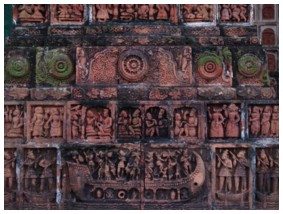 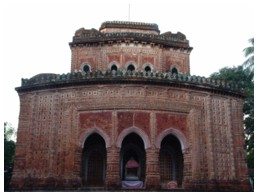 The
Kantanagar Temple close to Dinajpur is one of the most famous monuments in
Bangladesh, and is built in honor of Kantaji,
a Hindu god. It is two stories high and
completely covered with terracotta figures, all elaborate and depicting
many different things, from Hindu religious scenes to boat trips and love
scenes (in dark corners). There used to be 9 towers on top of it, but
these were destroyed by the big earthquake of 1897. The
Kantanagar Temple close to Dinajpur is one of the most famous monuments in
Bangladesh, and is built in honor of Kantaji,
a Hindu god. It is two stories high and
completely covered with terracotta figures, all elaborate and depicting
many different things, from Hindu religious scenes to boat trips and love
scenes (in dark corners). There used to be 9 towers on top of it, but
these were destroyed by the big earthquake of 1897.
The temple was built between 1704 and 1752 by the Maharaja Prannath and
his adopted son Ramnath. In those days, when
Bangladesh was not an
independent country and the
British were still around, the Hindus were the
most powerful population group. They were zamindars, feudal landowners,
and they used the Muslims to work for them as peasants, and probably in
the case of the temple they used them to do the building work. The country
was still wealthy back then, but some people say that the wealth
evaporated as a result of this zamindars system and the dictatorial
British. Anyway, the situation has turned around completely after the
independence of 1971, and the Muslims with 80% are now by far the
majority. |
|
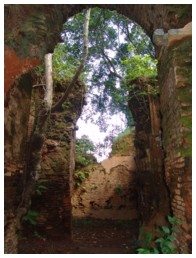 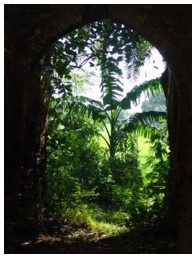 Whatever
the cause may have been, the wealth has gone, the country is independent
but extremely poor and also power relations have changed considerable. In
the 20th century, the Hindu population has suffered considerably and many
of them have fled to
India, now being a separate country. The Muslim
population has more power now in Bangladesh, holding the large majority.
The life of Hindus is not threatened nowadays, but their former wealth has
no more returned. Whatever
the cause may have been, the wealth has gone, the country is independent
but extremely poor and also power relations have changed considerable. In
the 20th century, the Hindu population has suffered considerably and many
of them have fled to
India, now being a separate country. The Muslim
population has more power now in Bangladesh, holding the large majority.
The life of Hindus is not threatened nowadays, but their former wealth has
no more returned.
As both population groups are still not always the best of friends, and
especially fundamentalist Muslim groups don't look back with pleasure at
the historic Hindu times, some of the cultural inheritance in Bangladesh
is not always treated with the utmost respect. Hindu temples may be
deserted or just going to pieces.
Close to the Ramshagar lake, we found the
remnants of something that must have been a beautiful temple once, but the
only tourists to come and visit it it were us and a few rodents. The name
Ramshagar means "sea of Ram"; Ram was the son of king Ramnath, who also
participated in building the Kantaji temple, and who dug out this sea
between 1700 and 1750 to provide the population of Dinajpur with water.
His son Ram is said to have died in this process, and as a tribute to him,
the water was called Ramshagar, even though it is only 400,000 square
meters large, and thus hardly a sea.
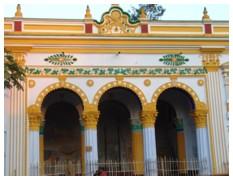 Even though the temple has gone to pieces, the size and beauty of the park
around Ramshagar lake still are a proof of a wealthy former owner and
times that were once good. Many people come here to escape the busy
town of Dinajpur and have their picnic and swim in the clean and clear
water of the lake.
Rickshaws are parked all around the lake to take the
weekend tourists for a ride. Even though the temple has gone to pieces, the size and beauty of the park
around Ramshagar lake still are a proof of a wealthy former owner and
times that were once good. Many people come here to escape the busy
town of Dinajpur and have their picnic and swim in the clean and clear
water of the lake.
Rickshaws are parked all around the lake to take the
weekend tourists for a ride.
There is also a rajbari (house of a former ruler) at the north side of Dinajpur, which shares the
premises with a Hindu Krishna temple. Even though the picture looks quite
nice, the thing is not much more than a facade, with the front wall
standing, but the rest of the building long ago fallen to pieces. |